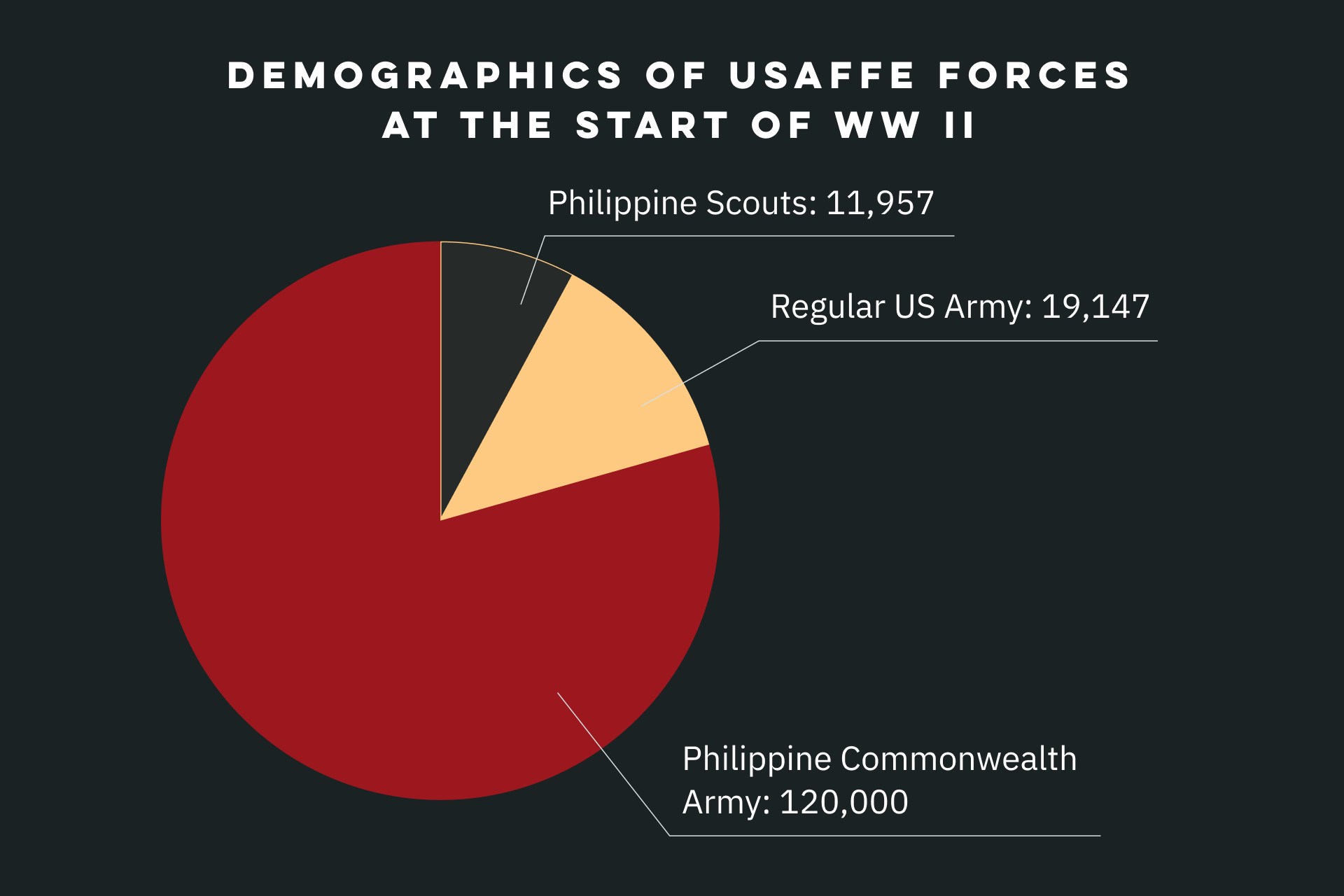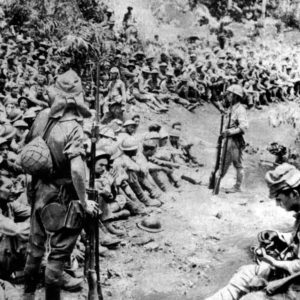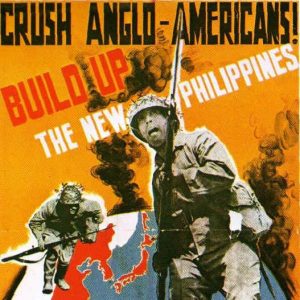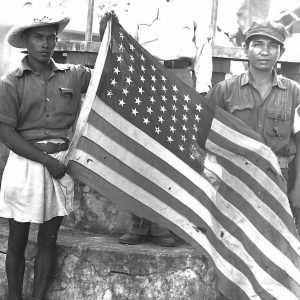Lesson Plan 3:

Filling in the Picture: World War II in the Philippines
Students trace the course of the war in the Philippines by looking closely at illustrations, primary sources, an online exhibit and eyewitness accounts. Students are asked to “fill in the picture” of the war by selecting primary sources that add nuance, complexity and detail to the narrative of the war, and consider how artists make choices to influence our understanding of historical events.
Summary
Students use the online exhibit and illustrations to trace the course of World War II in the Philippines, then look for a primary source that “fills in the picture.”
U.S. History, World History | Middle School, High School | 1-2 class periods
Materials
- Infographic: USAFFE Forces, 1941
- Illustrations of WWII events in the Philippines:
- Under One Flag online exhibit
Grade Level/Subject
Common Core: Middle School
- CCSS.ELA-LITERACY.RH.6-8.1 Cite specific textual evidence to support analysis of primary and secondary sources.
- CCSS.ELA-LITERACY.RH.6-8.7 Integrate visual information (e.g., in charts, graphs, photographs, videos, or maps) with other information in print and digital texts.
- CCSS.ELA-LITERACY.RH.6-8.9 Analyze the relationship between a primary and secondary source on the same topic.
Common Core: High School
- CCSS.ELA-LITERACY.RH.11-12.1 Cite specific textual evidence to support analysis of primary and secondary sources, connecting insights gained from specific details to an understanding of the text as a whole.
- CCSS.ELA-LITERACY.RH.11-12.2 Determine the central ideas or information of a primary or secondary source; provide an accurate summary that makes clear the relationships among the key details and ideas.
- CCSS.ELA-LITERACY.RH.11-12.9 Integrate information from diverse sources, both primary and secondary, into a coherent understanding of an idea or event, noting discrepancies among sources.
UCLA Public History Initiative | US History Content Standards
- Era 8, Standard 3: The causes and course of World War II, the character of the war at home and abroad, and its reshaping of the U.S. role in world affairs
UCLA Public History Initiative | World History Content Standards
- Era 8, Standard 4: The causes and global consequences of World War II
Instructions
1. Infographic (10 minutes)
Start the lesson by reviewing the size of U.S. forces in the Philippines at the start of the war.
2. Presentation (15-20 minutes)
Walk through the six stages of the war in the Philippines, introducing each period with a close examination of images from the Under One Flag exhibit.
After each new illustration is introduced, ask students to look closely at the illustrations:
-
What’s happening in the image?
-
What’s the tone or feeling created by the image? What choices by the artist convey that meaning?
-
What details need more information to understand?
After analyzing the image, provide a few key details about the stage of the war, but tell students that they will be investigating the war in more depth later.
To make this step less teacher-focused, break students into groups of six and ask each student to take one of the illustrations, read the exhibit to understand what’s happening at that stage of the war, then teach the illustration and history to their fellow group mates. You may want to lead students through a close examination of the first illustration, then let them complete the rest on their own.
3. Independent Student Work (35-40 minutes)
Assign students (either working independently or in small groups) one of the six illustrations/stages of the war. (It’s okay if more than one group/student is working on each stage.) Direct students to explore the online exhibit for that section of the war to “fill in the picture.” Ask students to find clues in the exhibit text, primary sources and oral histories that explain details in the image. Then, ask students/groups to select one primary source or oral history excerpt that they think is especially important to “fill in the picture” by adding nuance, complexity or detail to the image as it was discussed in the class and prepare a short presentation (3-5 minutes) of what their object is and why they selected it.
4. Presentations & Concluding Discussion (20 minutes)
Ask students to share their objects with the full class. Following presentations, ask students to synthesize (in discussion or writing) the major ideas by answering these questions:
-
How do the artistic renderings relate back to primary sources and historical scholarship? What choices does the artist make to influence how you understand and feel about the history being presented?
-
How did Filipinos support the American war effort in the Philippines?
-
What promises did the Americans make to Filipinos throughout the war? What expectations did Filipinos have of Americans at the end of the war?
Related Explainers
US Forces in the Philippines During World War II
During the colonial period, the US maintained a military presence throughout the Philippines, establishing military and naval bases near Manila, at Corregidor and throughout the archipelago. In the 1910s, the U.S. Army formed a new unit, the Philippine Scouts, who by the 1920s outnumbered regular Army soldiers in the Philippines. Thousands of Filipinos also joined the U.S. Navy in the 1920s and 1930s. After the Tydings-McDuffie Act of 1934, the Philippine Commonwealth also established its own armed forces, the Philippine Commonwealth Army, designed and trained by the U.S. military. In July 1941, in anticipation of war with Japan and the need to defend the Philippines, President Roosevelt combined all of these forces into one: United States Armed Forces of the Far East (USAFFE). All USAFFE soldiers now served under one flag, under the command of General Douglas MacArthur.
Against this force, the Japanese sent more than 300,000 soldiers to invade the Philippines starting in December 1941. After the fall of the Philippines in May 1942, thousands of Filipino guerrillas resisted Japanese occupation, cooperating and communicating with the U.S. military for the duration of the war. At least 100,000 guerrillas fought in the war.
U.S. law guaranteed that all members of the U.S. Armed Forces during World War II would receive equal pay. The Nationality Act of 1940 promised that foreign nationals serving in the U.S. military would have the right to be naturalized as citizens. It also promised that veterans would receive healthcare and hospitalization if they sustained injuries while fighting, and that they or their widows and children would receive pensions after their service. Like all people serving in the U.S. military during World War II, Filipinos believed they would be guaranteed these and other veterans benefits.

Focus Questions
-
What percentage of U.S. forces in the Philippines were Filipinos?
-
How important were Filipino service members to the U.S.’s plan to defend the Philippines against possible Japanese invasion?
-
What expectations did Filipinos have in return for their service in the U.S. military?




